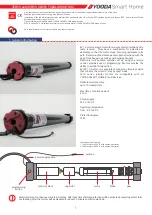
STORING YOUR ENGINE
- 18 -
2
、
Change the engine oil.
3
、
Remove the spark plugs.
4
、
Pour a tablespoon (5-10 cc) of clean engine oil into the cylinder.
5
、
Pull the starter rope several times to distribute the oil in the cylinder.
6
、
Reinstall the spark plugs.
7
、
Pull the starter rope slowly until resistance is felt. This will close the valves so
moisture cannot enter the engine cylinder. Return the starter rope gently.
8
、
Put the out case on the engine and place in the ventilated and dry area.
If your engine will be stored with gasoline in the fuel tank and carburetor, it is important to
reduce the hazard of gasoline vapor ignition. Select a well-ventilated storage area away
from any appliance that operates with a flame, such as a furnace, water heater, or clothes
dryer. Also avoid any area with a spark-producing electric motor, or where power tools are
operated.
If possible, avoid storage areas with high humidity, because that promotes rust and
corrosion.
Be sure all fuel has been drained from the fuel tank, to reduce the possibility of fuel
leakage.
Position the equipment so the engine is level. Tilting can cause fuel or oil leakage.
With the engine and exhaust system cool, cover the engine to keep out dust. A hot engine
and exhaust system can ignite or melt some materials. Do not use sheet plastic as a dust
cover. A nonporous cover will trap moisture around the engine, promoting rust and
corrosion.
If equipped with a battery for an electric starter, recharge the battery once a month while
the engine is in storage. This will help to extend the service life of the battery.
Removal from Storage
Check your engine as described in the chapter CHECK BEFORE OPERATION.
If the fuel was drained during storage preparation, fill the tank with fresh gasoline. If you
keep a container of gasoline for refueling, be sure that it contains only fresh gasoline.
Gasoline oxidizes and deteriorates over time, causing hard starting.
If the cylinders were coated with oil during storage preparation, the engine may smoke
briefly at startup. This is normal.
TRANSPORTING
If the engine has been running, allow it to cool for at least 15 minutes before loading the
engine-powered equipment on the transport vehicle. A hot engine and exhaust system can
burn you and can ignite some materials.
Keep the engine level when transporting to reduce the possibility of fuel leakage.






































